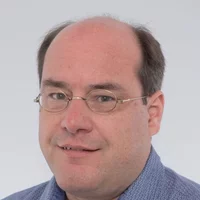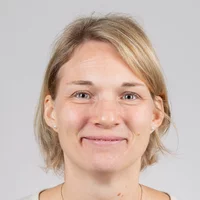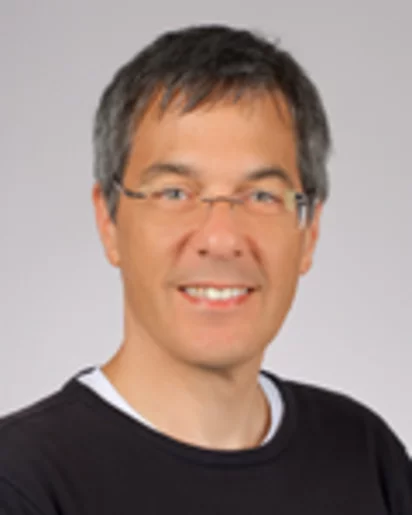Education
- Diploma of physics, October 1986, Swiss Federal Institute of Technology at Zurich (ETHZ), department of Mathematics and Physics. Thesis title: "Viability of Gluon Annihilation into a Higgs Associated to a Pair of Top Quarks as a Mechanism for detecting the Heavy Higgs in SSC". Diploma Advisors: Prof. C. Schmid and Prof. D. Wyler.
- Ph.D., October 1994, University of Illinois at Urbana-Champaign (UIUC), department of Physics. Thesis Title: "The Problem of Spin and Charge Separation". Thesis Advisor: Prof. Eduardo Fradkin.
Research Activities / Specialties
- Theoretical condensed matter physics
- Disordered systems
- Mesoscopic physics
- Strongly correlated electronic systems
Projects
Theoretical condensed matter physics aims at constructing ``simple'' models that can describe the phenomenology observed in crystalline solids, amorphous materials, rubber like materials, fluids, etc. Some of the great triumphs of condensed matter theory have been to provide a simple and coherent picture for such diverse phenomena as the existence of a crystalline, magnetic, metallic, and superconducting state of matter. More mundane (though highly non-trivial) questions such as how does paper crumble have also been addressed with the tools of theoretical condensed matter physics. At the multidisciplinary frontiers of theoretical condensed matter physics, models for earthquakes, protein folding, HIV, stock-market, automobile traffic, etc, have been proposed. Traditionally, all these systems have been thought of, to some extent, as very large collections of ``simple'' identical constituents that interact according to some set of rules. (With the emergence of nanotechnology, it is now possible to study very small collections of simple constituents in contact with ``large reservoirs''. This is the field of mesoscopic physics.) For example, if one is interested in the vibrational modes of a crystal, the ``simple'' constituent is an atom and, to a first approximation, the interaction between two neighboring atoms is a linear restoring force. In another example, if one is interested in the effect of shaking a sand-glass one can start with the simplification that each sand-grain is a sphere and that no two sand-grain can overlap in the sand-glass. The essential difference between these two examples arises from the relevant length and time scales. Because of its tiny size a single atom obeys the rules of quantum mechanics whereas the much larger sand grain obeys the rules of classical mechanics. Keeping in mind this important difference, the challenge to the condensed matter physicist is, in both cases, to extract what properties of these complex (by the very large number of the elementary constituents) systems can be measured and calculated reliably. In turn a sufficiently detailed knowledge of intrinsic properties of complex system can serve as a definition of more general phenomenon that might even transcend the given complex system. For example, the existence of vibrational modes in a crystal is the manifestation of the phenomenon of spontaneous symmetry breaking, a phenomenon that applies more generally to magnets, superconductors, the electro-weak interaction, etc. Another example is that of a conventional metal as defined by the property that the resistivity obeys a certain power law dependence on temperature at sufficiently low temperatures. This property can be entirely ascribed to the fact that a gas of electron is responsible for charge transport in a metal and that quantum mechanics tells us that electrons obey the so-called Fermi-Dirac statistics. This is why microscopically different materials, say Li, Na, K, Rb, Cs, Cu, Ag, etc, share the same temperature dependence of their resistivity at low temperatures, i.e., are all metals at a macroscopic scale.
Disordered systems:
Disorder is ubiquitous in condensed matter physics. No crystalline structure, no sand-glass is perfect in the sense that, in practice, a few percent of atoms (sand-grains) might have been exchanged with impurities through contamination in the growth process of the crystal or in the preparation of the sand-glass. I am mostly interested in the effect of disorder on quantum systems (i.e., at low temperatures): What is the effect of disorder on the vibrational modes of a perfect crystal, transport properties of a metal, magnetic response of an ordered array of magnetic moments, thermal transport in a superconductor, electrical response of an array of flux lines?
Mesoscopic physics:
Whereas condensed matter physics has always dealt with a macroscopically large number of elementary constituents (electrons or sand-grains), the progress of nanotechnology has opened up a new field of research by allowing the isolation of few constituents from its macroscopically large condensed matter reservoir. The canonical example is that of a quantum dot. A two dimensional gas of electron is fabricated first by layering different types of semi-conductors (hetero-junctions). One then applies very small gates on top of the hetero-junctions. The gates act as potential barriers for the two-dimensional gas. In this way it is possible to form an island (the quantum dot) of few electrons surrounded from the reservoir of electron (the two-dimensional gas) by a (tunable) potential barrier. The number of electrons residing on the quantum dot, their life-time (i.e., the coupling strength to the reservoir), the strength of disorder, etc, are all tunable parameters. In mesoscopic devices, fundamental questions ranging from the quantum nature of the electron to the role played by interactions can be studied with ever greater experimental flexibility (in the sense of tunability of parameters). Because of the tunability of parameters such as the gate voltage, the number of electrons on the quantum dot, and the strength of the disorder it is now possible to access physical regimes that once were considered of purely academic interest and pose new theoretical challenges.
Strongly correlated electronic systems:
Quantum systems for which interactions among the ``elementary'' constituents, say electrons, are effectively strong is nowadays referred to as strongly correlated systems. The most prominent examples of strongly correlated electronic systems are the fractional quantum Hall effect and high-temperature superconductivity. The simple metallic model by which electrons are treated as an essentially non-interacting gas (the Fermi-Liquid theory) is invalidated by the correlations induced through the effectively strong Coulomb interaction in strongly correlated electronic systems. There are many more examples of strongly correlated systems among organic materials and heavy fermions compounds. From a conceptual point of view, the trademark of strongly correlated systems is that perturbation theory around the idealization of the Fermi gas breaks down. Aside for one-dimensional physics, there are essentially no known reliable non-perturbative technique available to us to this date to confront strongly correlated systems. This is certainly true of analytical approaches. Moreover, numerical approaches suffer greatly from the relatively small system sizes that are currently accessible. The study of strongly correlated systems thus represents one of the frontiers of condensed matter physics.
Publications (Selection)
Fractional topological liquids with time-reversal symmetry and their lattice realization,
Titus Neupert, Luiz Santos, Shinsei Ryu, Claudio Chamon, and Christopher Mudry,
Phys. Rev. B 84, 165107 (2011)
Fractional quantum Hall states at zero magnetic field,
Titus Neupert, Luiz Santos, Claudio Chamon, and Christopher Mudry,
Phys. Rev. Lett. 106, 236804 (2011)
Masses in graphene-like two-dimensional electronic systems: topological defects in order parameters and their fractional exchange statistics,
Shinsei Ryu, Christopher Mudry, Chang-Yu Hou, and Claudio Chamon,
Phys. Rev. B 80, 205319 (2009).
Electron fractionalization in two-dimensional graphenelike structures,
Chang-Yu Hou, Claudio Chamon, and Christopher Mudry,
Phys. Rev. Lett. 98, 186809 (2007).
Universal Scaling Relations in Strongly Anisotropic Materials,
M. B. Hastings and C. Mudry,
Phys. Rev. Lett. 96, 027215 (2006).
From quantum mechanics to classical statistical physics: generalized Rokhsar-Kivelson Hamiltonians and the "Stochastic Matrix Form" decomposition,
Claudio Castelnovo, Claudio Chamon, Christopher Mudry, and Pierre Pujol,
Annals of Physics, 318, 316 (2005).
Density of states for the pi-flux state with bipartite real random hopping only: A weak disorder approach,
by C. Mudry, S. Ryu, and A. Furusaki,
Phys. Rev. B 67, 064202 (2003).
Localization and delocalization in dirty superconducting wires,
P. W. Brouwer, A. Furusaki, I. A. Gruzberg, C. Mudry,
Phys. Rev. Lett., 85, 1064 (2000).
Density of states in coupled chains with off-diagonal disorder,
P. W. Brouwer, C. Mudry, and A. Furusaki,
Phys. Rev. Lett., 85, 2913 (2000).
Delocalization in coupled one-dimensional chains,
P. W. Brouwer, Christopher Mudry, B. D. Simons, and A. Altland,
Phys. Rev. Lett., 81, 862 (1998).
Localization in two dimensions, Gaussian field theories, and multifractality,
Claudio de C. Chamon, Christopher Mudry, and Xiao-Gang Wen,
Phys. Rev. Lett. 77, 4194 (1996).
Liouville theory as a model for prelocalized states in disordered conductors,
I. Kogan, Christopher Mudry, and A. M. Tsvelik,
Phys. Rev. Lett. 77, 707 (1996).
Two-dimensional conformal field theory for disordered systems at criticality,
Christopher Mudry, Claudio Chamon, and Xiao-Gang Wen,
Nucl. Phys. B466, 383 (1996).
Mechanism of spin and charge separation in one dimensional quantum antiferromagnets,
Christopher Mudry and E. Fradkin,
Phys. Rev. B 50, 11409 (1994).
Separation of Spin and Charge Quantum Numbers in Strongly Correlated Systems,
Christopher Mudry and Eduardo Fradkin,
Phys. Rev. B 49, 5200 (1994).
Ground States of infinite-range spin-1/2 quantum Heisenberg antiferromagnets,
Christopher Mudry and E. Fradkin,
Phys. Rev. B 40, 11177 (1989).
Submissions to arXiv.org
Curriculum Vitae
Download Christophers CV
Teaching and Education
Field Theory in Condensed Matter Physics, ETHZ, 2002-present.
Abelian bosonization, EPFL, Spring 2016.
Interactions in Topological Matter, School on Topological Quantum Matter, Harish-Chandra Research Institute, Allahabad, February 2015.
Three lectures on fractional topological insulators, Topological Aspects of Condensed Matter Physics, Les Houches 2014 Session CIII, August 2014.
Physique du solide III, EPFL, Fall 2007.
Field Theory in Condensed Matter Physics, University of Zurich, Spring 2001.


